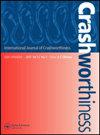Damage mechanisms and analytical model of CFRP laminate under low-velocity normal and oblique impacts
IF 2
4区 工程技术
Q3 ENGINEERING, MANUFACTURING
引用次数: 0
Abstract
AbstractThe present work investigates the energy absorption performance of carbon fibre-reinforced polymer (CFRP) laminates subjected to low-velocity normal and oblique impacts. Experimental tests are conducted on laminates exposed to varying impact energies at both normal and oblique angles. The numerical model is developed to simulate the dynamic response of the CFRP. The research employs a combination of experimental and numerical methods to reveal the underlying damage mechanisms. The changes observed in the oblique impact response are explained through an analysis of the damage mechanisms. Analytical models for each energy absorption mechanism are proposed based on the principles of energy conservation and the theory of large bending deformation of anisotropic materials. The energy absorption performance of the laminates under oblique impacts, considering rebound and penetration conditions, is discussed. It is found that the delamination is the primary energy absorption mechanism of CFRP laminate under rebound conditions, while elastic deformation of fibres is the primary energy absorption mechanism under penetration conditions. Furthermore, the energy absorption performance of the laminate is found to be affected by the peak force and effective thickness of the plate, which change with the oblique angle. This paper makes a significant contribution by utilising experimental, numerical, and theoretical approaches to gain insights into the damage mechanisms of laminates subjected to oblique impacts.Keywords: CFRPlow-velocity impactoblique impactdamage mechanismanalytical model Disclosure statementNo potential conflict of interest was reported by the author(s).Additional informationFundingThe authors acknowledge the financial support provided by the cooperative scientific research project of ‘Chunhui Program’ of Ministry of Education (HZKY20220292), the National Natural Science Foundation of China (51775228), the Natural Science Foundation of Shandong Province under Grant No. (ZR2020ME129), and the support from the International Joint Laboratory on Digital Laboratory of Lightweight Structure for Green Vehicle at the Harbin Institute of Technology for the research collaboration (ITCA10102001). The first author would like to acknowledge the China Scholarship Council (202006170147) during his visit to the Karlsruhe Institute of Technology (KIT).CFRP层合板低速法向和斜向冲击损伤机理及分析模型
摘要本文研究了碳纤维增强聚合物(CFRP)层合板在低速法向和斜向冲击下的吸能性能。实验测试了受不同冲击能的层压板,并对其进行了正交和斜角冲击试验。建立了碳纤维布动态响应的数值模拟模型。该研究采用实验与数值相结合的方法来揭示潜在的损伤机制。通过对损伤机制的分析,解释了斜冲击响应中观察到的变化。基于能量守恒原理和各向异性材料大弯曲变形理论,提出了各种吸能机理的解析模型。考虑回弹和侵彻条件,讨论了层合板在斜冲击下的吸能性能。研究发现,回弹条件下,分层是CFRP层合板的主要吸能机制,而侵彻条件下,纤维的弹性变形是CFRP层合板的主要吸能机制。此外,发现层压板的吸能性能受板的峰值力和有效厚度的影响,它们随斜角的变化而变化。本文利用实验、数值和理论方法对层合板受斜冲击的损伤机制进行了深入的研究。关键词:cfr犁速冲击冲击损伤机制分析模型披露声明作者未报告潜在利益冲突。作者感谢教育部“春晖计划”合作科研项目(HZKY20220292)、国家自然科学基金项目(51775228)、山东省自然科学基金项目(批准号:51775228)的资助。(ZR2020ME129),哈尔滨工业大学绿色汽车轻量化结构数字化实验室国际联合实验室(ITCA10102001)。第一作者在访问卡尔斯鲁厄理工学院(KIT)期间,向中国留学基金委(202006170147)表示感谢。
本文章由计算机程序翻译,如有差异,请以英文原文为准。
求助全文
约1分钟内获得全文
求助全文
来源期刊

International Journal of Crashworthiness
工程技术-工程:机械
CiteScore
3.70
自引率
10.50%
发文量
72
审稿时长
2.3 months
期刊介绍:
International Journal of Crashworthiness is the only journal covering all matters relating to the crashworthiness of road vehicles (including cars, trucks, buses and motorcycles), rail vehicles, air and spacecraft, ships and submarines, and on- and off-shore installations.
The Journal provides a unique forum for the publication of original research and applied studies relevant to an audience of academics, designers and practicing engineers. International Journal of Crashworthiness publishes both original research papers (full papers and short communications) and state-of-the-art reviews.
International Journal of Crashworthiness welcomes papers that address the quality of response of materials, body structures and energy-absorbing systems that are subjected to sudden dynamic loading, papers focused on new crashworthy structures, new concepts in restraint systems and realistic accident reconstruction.
 求助内容:
求助内容: 应助结果提醒方式:
应助结果提醒方式:


